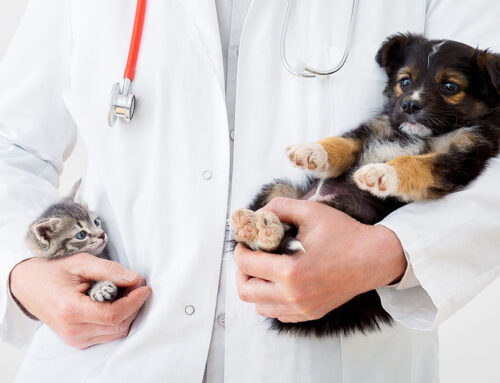You’ve recently realized that you have a pet-shaped hole in your life and—ideally, after some thought and careful research—you’re ready to fill the space with a furry, feathered, or finned friend. At this point, you’re probably excited and maybe a little nervous, which is a good thing—adopting a pet is a big decision that shouldn’t be taken lightly.
As you take the final steps on your pet adoption journey, use these tips from the Veterinary Medical Center of Indian River County to ensure you’re setting up your new pet for a happy and healthy life—and a long and beautiful friendship.
#1: Learn everything you can about your new pet
A pet should never be adopted on a whim. Instead, adoption should be the culmination of careful research and thoughtful consideration. Before you even begin searching for available pets, explore the species and breeds that appeal to you most to ensure you choose the best fit. Also, be honest with yourself about what you can provide (e.g., monetarily, space, time).
Important criteria you should know about each breed or species include:
- Physical care requirements
- Ongoing costs (e.g., food, grooming, health care, electricity for lights, heaters, or filters)
- Environment and space requirements (e.g., yard, apartment, aquarium, enclosure)
- Anticipated veterinary needs
- Common health conditions
- Behavior issues
- Daily exercise needs
- Temperament and common behavior problems
- Training
In addition to what you want, consider what your other household members want and need. Does everyone accept that you are adopting a pet? Is anyone allergic or fearful of pets? Will the pet have multiple caretakers? If not, who will provide for the pet if you are unavailable?
Although answering these questions may be difficult, asking them now will prevent tension and conflicts later, and the heartbreaking experience of returning the pet to the shelter or rescue.
#2: When possible, visit the pet several times before adopting
Once you find the individual pet who appeals to you, try to arrange several visits before finalizing the adoption. Spending extra time with the pet over several days or a week can give you a better sense of their personality and your compatibility. Find out if the rescue or shelter offers a foster-to-adopt opportunity where you can take the pet home on a trial basis to see if you are the best fit for each other.
#3: Assemble your pet supplies before adoption day
Your new pet’s “Gotcha day” (i.e., the day you welcome them home) will be busy and exciting —and the last thing you want is to leave your pet at home to run an errand because you forgot a necessary item on their supply list.
Do your research and ensure you have everything your pet needs. Your list will certainly be more detailed, but should include these basics:
- Species and life stage appropriate food
- Food and water dishes
- Crate, carrier, or cage
- Leash and collar or harness
- Enclosure for reptiles and small mammals
- Exercise pen
- Litter box and litter
- Potty pads or bells
- Toys in various shapes, sizes, and textures
- Pet-safe cleaning supplies for sanitization and cleaning up urine or solid waste
- Bedding
#4: Pet-proof your new pet’s area or set up their enclosure
Your pet should be confined to a small area (e.g., an exercise pen, large crate, small room) until they are fully acclimated and are behaving properly. Newly adopted pets are likely to be frightened and disoriented, and they may panic and try to escape. Others—especially puppies, kittens, and adolescent pets—may be destructive or suffer injury or death from household hazards.
Ensure the entire area is pet-proofed by removing household dangers, such as:
- Electrical cords
- Curtains
- Blind cords
- Breakable items
- Trash cans
- Medications
- Toxic houseplants
- Cleaning products and air fresheners
- Electronic equipment
- Sharp or small objects
To ensure you’ve done a thorough job, get on your hands and knees and view the world from your pet’s level. Remove anything that catches your eye, and then double-check your work against this Fear Free Happy Homes 35-point list.
#5: Schedule your pet’s arrival for a long weekend
Your adopted pet’s homecoming will be a major transition, and they’ll need a consistent and reassuring presence to help them adjust. Take a few days off work or schedule your pet’s adoption for a Friday afternoon.
#6: Visit the veterinarian to confirm your pet’s health
The Veterinary Medical Center of Indian River County team recommends that you bring in your pet for a full examination during the first week after adoption. Although they may have received veterinary care at the shelter, a comprehensive veterinary examination can detect hidden health issues or congenital conditions, and provides the opportunity for you to ask questions about your pet’s health and care.
#7: Give your pet time to acclimate to their new life

Rescue and shelter pet advocates generally use the 3-3-3 rule to help new pet adopters know what to expect during their pet’s first three months. According to the rule:
- Three days — During the first three days pets may feel overwhelmed, nervous, and stressed.
- Three weeks — During the first three weeks, pets begin to reveal their personality, learn about their environment, and feel more relaxed.
- Three months — After three months, adopted pets are comfortable in their home and beginning to build a trusting bond with their new owner.
While you may have felt love at first sight, your new pet is going through a major transition, and showing them consistent and compassionate care is the best thing you can do to help them learn to trust you.
The Veterinary Medical Center of Indian River County team can’t wait to meet your newest addition—but we want to ensure you make the best possible choice. Contact our expert team if you have additional questions about pet adoption, veterinary care, husbandry, or training.







Leave A Comment